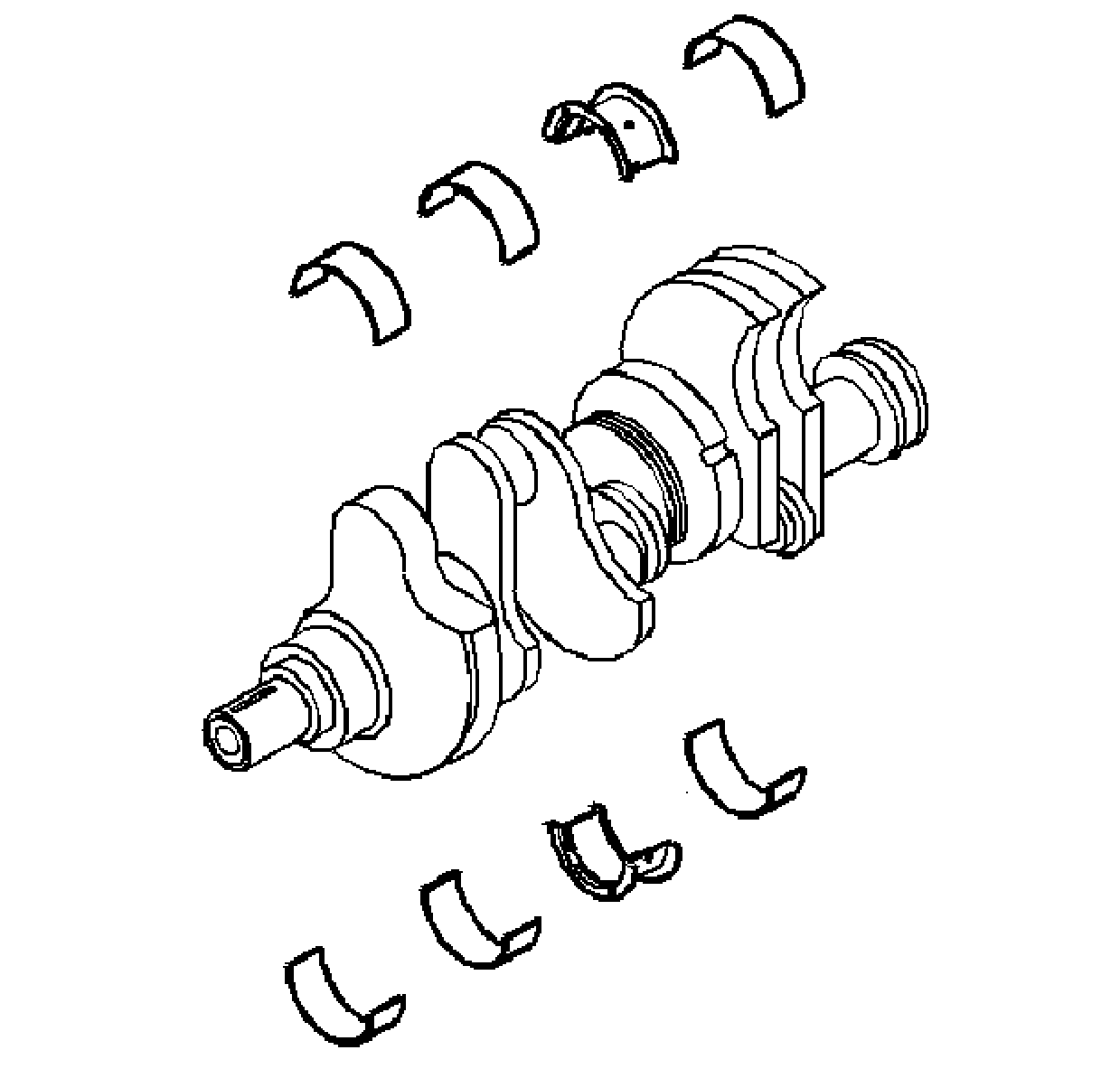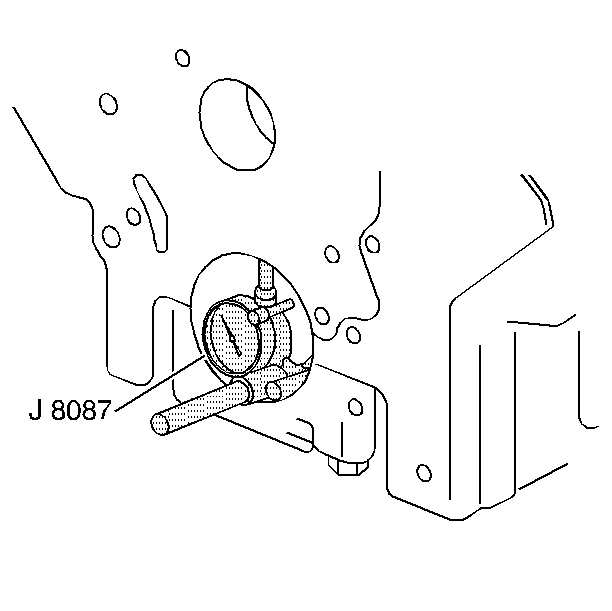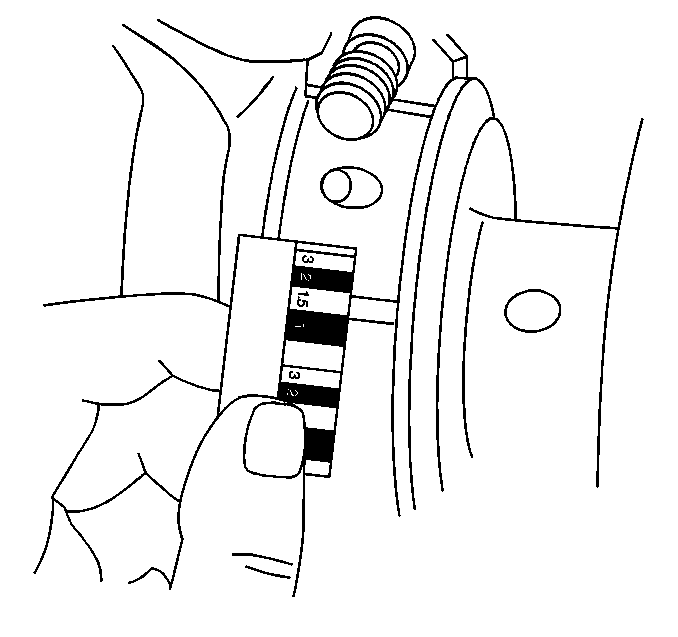Special Tools
J 8087 Cylinder Bore Gage
For equivalent regional tools, refer to
Special Tools.

- Clean the crankshaft of the following elements:
- Inspect the crankshaft oil passages for obstructions.
- Inspect the crankshaft keyway for nicks or wear.
- Inspect the crankshaft threads.
Note: If cracks, severe gouges or burned spots are found, the crankshaft must be replaced. Slight roughness may be removed with a fine polishing cloth soaked in clean engine oil. Burrs may be removed with a fine oil stone.
- Inspect the crankshaft bearing journals and the crankshaft thrust surfaces for the following conditions:
| • | Overheating, discoloration |
- Inspect the corresponding crankshaft bearings for embedded foreign material and determine the source.
Note: Note the location of the crankshaft main bearing high spots. If they are not in line, the crankshaft is bent and must be replaced.
- Inspect the crankshaft bearings for uneven side-to-side wear. This may indicate a bent crankshaft or a tapered bearing journal.

Note: The crankshaft bearings are the precision insert type. The crankshaft bearings are available in standard and various undersizes.
- Inspect the outer surfaces of the crankshaft bearings for the following conditions:
| • | Wear - surface wear indicates either movement of the insert or high spots in the surrounding material, spot wear. |
| • | Overheating or discoloration |
| • | Looseness or rotation indicated by flattened tangs and wear grooves |
- Inspect the thrust surfaces of the main thrust bearing for the following conditions:
| • | Grooving, grooves are caused by irregularities of the crankshaft thrust surface. |

Note: If crankshaft bearing failure is due to other than normal wear, investigate the cause. Inspect the crankshaft or connecting rod bearing bores.
- Using the
J 8087 gage
inspect the connecting rod bearing bores or crankshaft main bearing bores using the following procedure:
| 10.1. | Tighten the bearing cap to specification. |
| 10.2. | Measure the bearing bore using
J 8087 gage
for taper and out-of-round. |
| 10.3. | No taper or out-of-round should exist. |
Bearing Selection
Measure the bearing clearance to determine the correct replacement bearing insert size. There are two methods to measure bearing clearance. Method A gives more reliable results and is preferred.
| • | Method A yields measurement from which the bearing clearance can be computed. |
| • | Method B yields the bearing clearance directly. Method B does not give any indication of bearing run-out. |
Method A

Note: Do not mix inserts of different nominal size in the same bearing bore.
- Measure the crankshaft bearing journal diameter with a micrometer in several places, 90 degrees apart. Average the measurements.
- Measure the crankshaft bearing journal taper and runout.
- Install the crankshaft bearing inserts. Tighten the bearing cap bolts to specification.
- Measure the connecting rod inside diameter in the same direction as the length of the rod with an inside micrometer.
- Measure the crankshaft main bearing inside diameter with an inside micrometer.
- Select a set of bearing inserts that will produce the desired clearance.
- If the specified clearances cannot be met, the crankshaft journals must be reconditioned and undersized bearing inserts installed.
Method B

Note: Do not mix inserts of different nominal size in the same bearing bore.
- Clean the used bearing inserts.
- Install the used bearing inserts.
- Place a piece of gaging plastic across the entire bearing width.
- Install the bearing caps.
Caution: In order to prevent the possibility of cylinder block or crankshaft bearing cap damage, the crankshaft bearing caps are tapped into the cylinder block cavity using a brass, lead, or a leather
mallet before the attaching bolts are installed. Do not use attaching bolts to pull the crankshaft bearing caps into the seats. Failure to use this process may damage a cylinder block or a bearing cap.
- Install the bearing cap bolts to specification.
Note: Do not rotate the crankshaft.
- Remove the bearing cap, leaving the gaging plastic in place. It does not matter whether the gaging plastic adheres to the journal or to the bearing cap.
- Measure the gaging plastic at its widest point with the scale printed on the gaging plastic package.
- Remove the gaging plastic.
- Select a set of bearing inserts that will produce the desired clearance.





